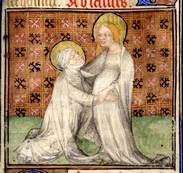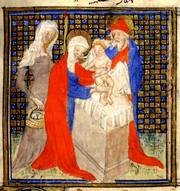Tutorial
What is a Book oh
Hours?
Where does the name Book
of Hours come from?
Canonical hours
The structure
What does use mean?
Decoration
Decoration-Calendar
Decoration-Style
Decoration-Meaning
Circulation
Illuminators
Where does the name Book
of Hours come from?
Canonical hours
The structure
What does use mean?
Decoration
Decoration-Calendar
Decoration-Style
Decoration-Meaning
Circulation
Illuminators


Visitation. Bedford Master. Beginning of XV cent.
What is a Book
of Hours?
Books of Hours were created in the thirteenth century as a derivation of the breviary and the psalter and were used by lay people to pray during the day. Each Book of Hours is unique exactly as a tailor-made suit, hand made following the client's desires and needs.
Books of Hours were created in the thirteenth century as a derivation of the breviary and the psalter and were used by lay people to pray during the day. Each Book of Hours is unique exactly as a tailor-made suit, hand made following the client's desires and needs.
Where does the name Book of Hours come from?
Historiated initial
Master of
Crescenzago
Master of
Crescenzago

Canonical hours
We have eight canonical hours:
- Matins: about midnight
- Lauds: at dawn
- Prime: when one wakes up, at about 6 a.m.
- Terce: at about 9 a.m.
- Sext: at lunchtime, about midday
- Nones: at about 3 p.m.
- Vespers: at sunset
- Compline: before going to bed

Crucifixion. Bedford Master.

Visitation. Grisaille miniature
Gold burnished
initial.
initial.

The structure
At the front of a Book of Hours we always find the calendar; at the end we can find some additional prayers to the Saints. The text is usually written in Latin but some special prayers at the end of the book are in vulgar tongue. Sometimes, especially in Germany or in the Netherlands, the books are entirely written in vulgar tongue.
The most common structure is:
Calendar
Gospel sequences
Hours of the Virgin divided in eight canonical hours
Hours of the Cross divided in eight canonical hours
Hours of the Holy spirit divided in eight canonical hours
Penitential Psalms and Litanies
Office of the dead
Prayers to the saints

Flight
into Egypt. Second half XIV century.

Borders
with acanthus, flowers and gold rinceaux. Book of Hours, France,
about 1470


«Grillo gotico»

The
male donor of the book kneeling in prayer

Presentation in the temple. Beginning of XV century.

Annunciation. Troyes Master.

Adoration of Magi.
Workshop of the Boucicaut Master.
Workshop of the Boucicaut Master.
Annunciation.
Ango Master.
XVI century.
Ango Master.
XVI century.

Pentecost.
Book of Hours,
France. End XVI cent.
Book of Hours,
France. End XVI cent.


St. Margaret.
Book of Hours, 1444.
Book of Hours, 1444.
What does use mean?
Prayers in a Book of Hours can be different from a book to another according to the liturgy used where the book is produced or to the buyer's desires: i.e. following the use of Rome the first hymn in the Hours of the Virgin starts with the verse "Quem terra ponthus", while according to the use of Paris it starts with the verse "O quam glorifica luce".
Decoration
Every Book of Hours was decorated and each part of the book was decorated from capitals to illuminations painted by great artists. Illuminations opened the main sections of a Book following a well-defined scheme.
The Hours of the Virgin, the most important Hours in a Book, were usually introduced by an illumination showing the Annunciation at Matins. Each canonical hour could be introduced by an illumination: the Visitation at Lauds, the Nativity at Prime, the Annunciation to the shepherds at Terce, the Adoration of the Magi at Sext, Christ Child's presentation in the temple at Nones, the Massacre of the Innocents or the Flight into Egypt at Vespers. The sequence ended often with the Death of the Virgin or the Coronation of the Virgin at Compline.
The Hours of the Cross were usually opened by an illumination showing the Crucifixion, while those of the Holy Spirit were introduced by the Pentecost scene. King David playing the harp appears often before the Penitential psalms and a funeral scene opens the Office of the dead. Here we can also find the Final Justice (in more ancient books) or Job who meets his friends. At the end of the books there were illuminations that represented Saints and Martyrs often with their symbols.
Decoration-Calendar
The calendar showed the Signs of the Zodiac; in richer books appeared also agricultural activities related to the four seasons such as reaping, grapegathering, or pork killing and sometimes scenes from aristocratic life.
Decoration-Style
ABook of Hours in gothic style of the fourteenth century has pages enriched with decorated borders, which show ivy branches in gold and fantastic animals (droleries). Illuminations have golden, bright backgrounds. Nature is stylized: here and there appear stones and vegetation. Also human figures are stylized but some faces show features.
In the fifteenth century golden backgrounds are replaced by skies and landscapes less stylized and enriched with vegetation. Figures gain volume, faces fill out, draperies soften up and we can find shadows and signs of perspective for the first time. Borders become richer and show acanthus branches, flowers, animals and fantastic creatures.
Decoration-Meaning
Pictures and illuminations had not only a decorative purpose: they were meant to integrate the text and to help meditation and praying, especially for those people who cannot read (illiteracy was spread even among reach people) who could remember what prayer to say or what was the subject to think about just looking at the illumination.
Beside the religious meaning and the solemnity of these books we find elements that remind us of a less serious dimension of life especially in the borders: strange creatures, half man and half animal, little monsters, fantastic creatures, the so-called "grillo gotico" according to Baltrusaitis. Shapes, animals, flowers and fantastic creatures in the borders have often a symbolic meaning.
Arose with no thorns is the symbol of the Virgin who was conceived immaculate: roses in Eden had no thorns. A rose with thorns is the symbol of martyrdom; red roses represent Jesus Christ's blood, while white roses are washed with Virgin Mary's tears. This flower appears in some episodes from the Holy Family's life and in scenes representing the Holy Grave.
The iris is another flower linked to the Virgin and it's related to the Annunciation, where it sometimes replaces the lily, or to the pain for Jesus' death.
The violet means modesty and humility and it is tied to the Virgin and to Jesus Christ.
Border
with
an imaginary
animal.
XVI century.
an imaginary
animal.
XVI century.

The lily in the Ancient Testament meant fertility and beauty while in the Middle Ages appeared as a present of Jesus to the saints. It means also chastity and pureness, appears in Annunciation scenes and reminds us of the Virgin. The pomegranate in Jesus' hands is a symbol of resurrection; in Virgin Mary's hands it means chastity.
Birds and butterflies symbolize the soul living the body after death. Snails can mean virtue and sobriety because they go back into theirs shells but also ambiguity and duplicity because they are hermaphrodite.
«Maître des Entrées
Parisiennes».
Legend of the three
Living and the
three Dead.
Parisiennes».
Legend of the three
Living and the
three Dead.

Circulation
One of the most fascinating aspect in the history of the Books of Hours is their circulation. These little books were spread all over Europe.
They were often used as presents on wedding, ordination ceremonies, or on important occasions.
The owners of these books usually annotated on the pages significant dates for their family such as weddings, births and deaths.
At the beginning noblemen and members of the Church purchased Books of Hours, but the growing middle classes started soon to buy this kind of books and the Book of Hour became a status symbol for its owner. Books of Hours are direct and tangible witnesses of one of the most important social evolutions in Europe between the Middle Ages and the Renaissance.
Quality and richness of the decoration depended on how much the owner could pay: books meant for middle and lower classes had few illuminations and were less decorated, while those meant for rich people were richer in decoration. Very rich people could choose the illuminator. The pages of these books were fields where artists could express themselves and their ability and at the same time the books were witnesses of the taste and the manners of their times. Illuminations give us back information about everyday life, clothes and furniture.
Master
of
Jean Rolin II.
Annunciation
to the Shepherds.
Detail.
Jean Rolin II.
Annunciation
to the Shepherds.
Detail.


Bedford
Master.
Annunciation
to the Shepherds.
Detail.
Annunciation
to the Shepherds.
Detail.
Illuminators
France was the land where Books of Hours were particularly spread during the fourteenth and the fifteenth century and many illuminators, both French and not, settled and worked in France.
Many illuminators are unknown. Some of them took the name of towns - Troyes Master -, of important customer - Bedford Master (Bedford was the English regent in France) or Boucicaut Master (Boucicaut was France Marshal) - or of masterpieces - Gerona Bible Master, Master of the Coronation of the Virgin -.
The most famous French illuminators are the Limbourg brothers - originally Flemish - who in about 1413 illuminated a world masterpiece, Les Très Riches Heures, for the Duke of Berry. This is one of the most important French art treasures and represents the climax in French illumination art.
Beside them there are other famous French illuminators such as Jean Pucelle, Jacquemart de Hesdin and Jean Fouquet, one of the major painters in France in the fifteenth century who was influenced by the Italian style.
Another important painter and illuminator between fifteenth and sixteenth century was Simon Bening, a Flemish illuminator, who decorated many Books of Hours.

